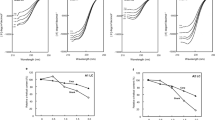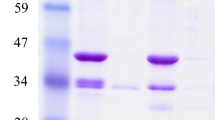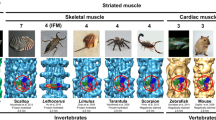Abstract
In order to elucidate the molecular mechanism of transglutaminase-mediated myosin crosslinking, a fluorescent monodansylcadaverine (MDC) was incorporated into carp Cyprinus carpio myosin and the reactive Gln residues were analyzed by cyanogen bromide cleavage. The fluorescence was predominantly detected in a 10.5 kDa BrCN fragment, assumed to be located in subfragment 2 of the myosin heavy chain. Furthermore, lysyl endopeptidase digestion of the 10.5 kDa fragment revealed that MDC was specifically incorporated into the 520th Gln residue of the subfragment 2 domain. When meat paste prepared from frozen walleye pollack (Theragra chalcogramma) surimi was incubated with MDC, the fluorescence was mostly observed in a 16 kDa BrCN fragment and also slightly detected in other three bands. By digesting the 16 kDa fragment with lysyl endopeptidase, it was elucidated that MDC was incorporated specifically into Gln-520 of myosin subfragment 2, as also detected in carp. This domain around Gln-520 is likely to be a critical region for the formation of myosin heavy chain dimers that both fish species have in common. In walleye pollack, other reactive Gln residues are presumed to exist at the C-terminus of the light meromyosin. This slight difference may have a significant effect on the capacity of myosin to form tetramers or even larger multimers.







Similar content being viewed by others
References
Folk JE (1980) Transglutaminases. Annu Rev Biochem 49:517–531
Ichinose A, Bottenus RE, Davie EW (1990) Structure of transglutaminases. J Biol Chem 265:13411–13414
Lorand L, Conrad SM (1984) Transglutaminases. Mol Cell Biochem 58:9–35
Tsukamasa Y, Sato K, Shimizu Y, Imai C, Sugiyama M, Minegishi Y, Kawabata M (1993) ε-(γ-Glutamyl) lysine crosslink formation in sardine myofibril sol during setting at 25°C. J Food Sci 58:785–787
Nozawa H, Mamegoshi S, Seki N (1997) Partial purification and characterization of six transglutaminases from ordinary muscles of various fishes and marine invertebrates. Comp Biochem Physiol B 118:313–317
Araki H, Seki N (1993) Comparison of reactivity of transglutaminase to various fish actomyosins. Nippon Suisan Gakkaishi 59:711–716
Harrington WF, Rodgers ME (1984) Myosin. Annu Rev Biochem 53:35–73
Lowey S, Slayter HS, Weeds AG, Baker H (1969) Substructure of myosin molecule: subfragments of myosin by enzymic degradation. J Cell Biol 42:1–29
Margossian SS, Lowey S (1982) Preparation of myosin and its subfragments from rabbit skeletal muscle. Methods Enzymol 85:55–71
Kunioka Y, Ando T (1996) Innocuous labeling of the subfragment-2 region of skeletal muscle heavy meromyosin with a fluorescent polyacrylamide nanobead and visualization of individual heavy meromyosin molecules. J Biochem 119:1024–1032
Seki N, Nakahara C, Takeda H, Maruyama N, Nozawa H (1998) Dimerization site of carp myosin heavy chains by the endogenous transglutaminase. Fish Sci 64:314–319
Maruyama N, Nozawa H, Kimura I, Satake M, Seki N (1995) Comparison of reactivity of transglutaminase to various fish actomyosins. Fish Sci 61:495–500
Wan J, Kimura I, Satake M, Seki N (1994) Effect of calcium ion concentration on the gelling properties and transglutaminase activity of walleye pollack surimi paste. Fish Sci 60:107–113
Wan J, Kimura I, Satake M, Seki N (1995) Causes of inferior gel-forming ability of salmon surimi paste. Fish Sci 61:711–715
Nauss KM, Kitagawa S, Gergely J (1969) Pyrophosphate binding to and adenosine triphosphate activity of myosin and its proteolytic fragments. J Biochem 244:755–765
Nozawa H, Seki N (2001) Purification of transglutaminase from scallop striated adductor muscle and NaCl-induced inactivation. Fish Sci 67:493–499
Laemmli UK (1970) Cleavage of structural proteins during the assembly of the head of bacteriophage T4. Nature 227:680–685
Towbin H, Staehelin T, Gordon J (1979) Electrophoretic transfer of proteins from polyacrylamide gels to nitrocellulose sheets: procedure and some applications. Proc Natl Acad Sci USA 76:4350–4354
Hirayama Y, Watabe S (1997) Structural differences in the crossbridge head of temperature-associated myosin subfragment-1 isoforms from carp fast skeletal muscle. Eur J Biochem 246:380–387
Watabe S, Hirayama Y, Nakaya M, Kakinuma M, Kikuchi K, Guo X, Kanoh S, Chaen S, Ooi T (1998) Carp expresses fast skeletal myosin isoforms with altered motor functions and structural stabilities to compensate for changes in environmental temperature. J Therm Biol 22:375–390
Imai J, Hirayama Y, Kikuchi K, Kakinuma M, Watabe S (1997) cDNA cloning of myosin heavy chain isoforms from carp fast skeletal muscle and their gene expression associated with temperature acclimation. J Exp Biol 200:27–34
Ojima T, Kawashima N, Inoue A, Amauchi A, Togashi M, Watabe S, Nishita K (1998) Determination of primary structure of heavy meromyosin region of walleye pollack myosin heavy chain by cDNA cloning. Fish Sci 64:812–819
Togashi M, Kakinuma M, Hirayama Y, Fukushima H, Watabe S, Ojima T, Nishita K (2000) cDNA cloning of myosin rod and the complete primary structure of myosin heavy chain of walleye pollack fast skeletal muscle. Fish Sci 66:349–357
Parry DAD (1980) Structure of rabbit skeletal myosin. Analysis of the amino acid sequence of two fragments from the rod region. J Mol Biol 153:459–464
McLachlan AD, Karn J (1982) Periodic charge distributions in the myosin rod amino acid sequence in muscle. Nature 299:226–231
Acknowledgments
We are grateful to Dr. N. Seki, Professor Emeritus of Hokkaido University, for helpful comments on this work. The present study was supported in part by Grant-in-Aid for Scientific Research No. 17580177 from the Japan Society for the Promotion of Science.
Author information
Authors and Affiliations
Corresponding author
Rights and permissions
About this article
Cite this article
Nozawa, H., Ezou, M. Identification of the glutamine residue that may be involved in the transglutaminase-mediated intramolecular crosslinking of carp and walleye pollack myosin. Fish Sci 75, 1445–1452 (2009). https://doi.org/10.1007/s12562-009-0165-2
Received:
Accepted:
Published:
Issue Date:
DOI: https://doi.org/10.1007/s12562-009-0165-2




